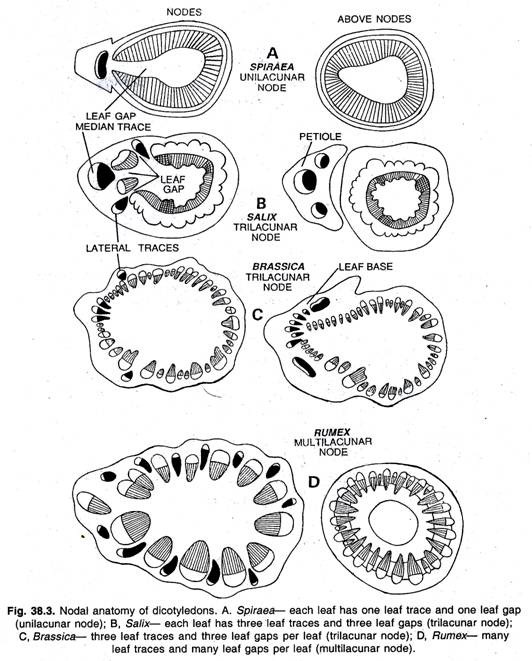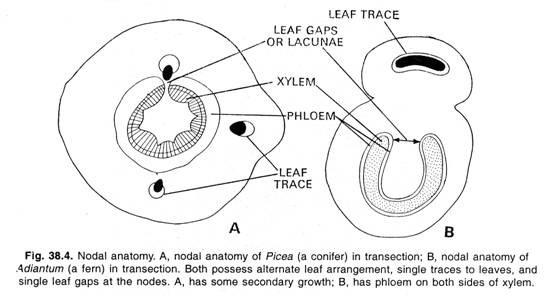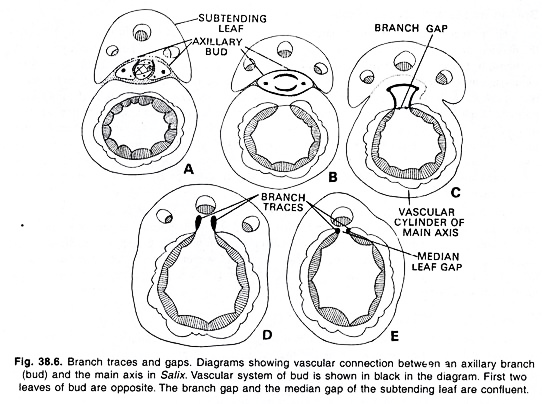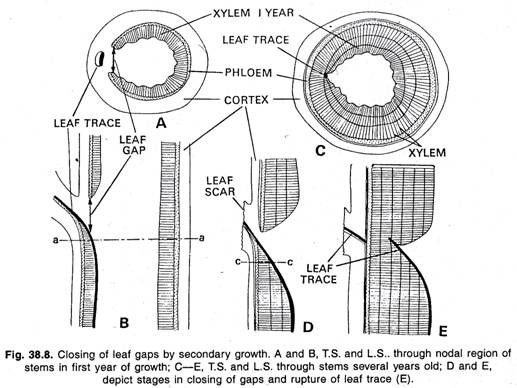The below mentioned article provides an overview of Nodal Anatomy of Plants. After reading this article you will learn about: 1. Nodal Anatomy in Leaf Traces and Leaf Gaps 2. Nodal Anatomy in Wheat (Monocot) Stem 3. Branch Traces and Branch Gaps 4. Closing of Leaf Gaps.
Nodal Anatomy in Leaf Traces and Leaf Gaps:
A shoot bears nodes’ and internodes. At each node, portions of the vascular system are deflected into the leaf, which is attached at this node. A vascular bundle located in the stem but directly related to a leaf, to represent the lower part of the vascular supply of this leaf, is termed the leaf trace.
The leaf trace is defined as follows— The leaf trace is a vascular bundle that connects the vascular system of the leaf with that of the stem. A leaf trace is extended between the base of a leaf and the point where it is completely merged with other parts of the vascular system in the stem. One or more leaf traces may be associated with each leaf.
In the shoot of a pteropsid (seed plants and ferns) where the leaf trace diverges into a leaf, it appears as though a portion of the vascular cylinder of the stem is deflected to one side. Immediately above the diverging trace, a parenchymatous tissue is being differentiated instead of vascular tissue in the vascular region of the stem for a limited distance.
The parenchy-matous regions in the vascular system of the stem, located adaxially from the diverging leaf traces, are called leaf gaps or lacunae. Actually these gaps are not breaks in the continuity of the vascular system of the axis. Lateral connections occur between the tissues above and below the gap. In transverse sections of an axis at the level of a leaf gap, the gap resembles an inter-fascicular area.
The gaps are quite conspicuous in the ferns and angiosperms where the vascular system in the inter-nodal parts of the stem forms a more or less continuous cylinder. In some ferns the leaves are so crowded that the gaps formed at the successive nodes overlap one another and the vascular cylinder appears highly dissected.
The transverse sections of such stems show a circle of vascular bundles with the parenchymatous leaf gaps. In certain ferns, gymnosperms and most angiosperms the vascular system consists of anastamosing strands. In such cases, the parenchyma that occurs above the diverging leaf trace becomes confluent with the interfascicular areas, thus the recognition of the gaps become uncertain.
There are three common types of nodes in the dicotyledons. The node with a single gap and a single trace to a leaf is known as unilacunar; the node with three gaps and three traces to a leaf (one median and two lateral) is known as trilacunar; and the node with several to many gaps and traces to a leaf is known as multi-lacunar.
The most accepted concept is that the trilacunar condition is primitive in the dicotyledons and that the unilacunar and the multi-lacunar have been derived from it. Several monocotyledonous plants possess leaves with sheathing bases and nodes with a large number of leaf traces separately inserted around the stem.
In ferns the number of traces to a leaf varies from one to many, but they are always associated with a single gap. In gymnosperms a unilacunar node is common.
The leaf trace relationships at the nodes are thought to be of phylogenetic importance, and therefore, nodal anatomy is concerned with the study of systematics and phylogeny of angiosperms.
Nodal Anatomy in Wheat (Monocot) Stem:
In the wheat stem the course of the vascular bundles through the internode and the leaf sheath is almost parallel. Near the node the leaf sheath is considerably thick and attains its maximum thickness just above its union with the stem.
On the other hand, the stem has the smallest diameter above the junction with the leaf sheath. The stem is hollow in the internode and solid at the node. The sheath remains open on one side at higher levels, just near the node. Massive collenchymatous bundle caps are present in the bundles of leaf sheath.
Just beneath the junction of the leaf sheath and stem the smaller of the leaf traces are prolonged in the peripheral part of the axis, and the larger leaf traces become part of the inner cylinder of strands.
The inter-nodal bundles located above the leaf insertion assume, just above the node a horizontal and oblique course (Fig. 38.7 C, D), and are reoriented toward a more peripheral position in the node and below it (Fig. 38.7 D, E).
These horizontal and oblique bundles variously branch and coalesce, and their number reduces. The large leaf traces and the bundles from the internode above the insertion of the leaf make the inner cylinder of the bundles of the next lower internode (Fig. 38.7 E).
In this cylinder approximately half of the bundles are leaf traces from the nearest leaf above and the other half of the bundles are from the internode above the insertion of the leaf (Fig. 38.7 E). The peripheral bundles are mostly leaf traces. The most conspicuous character of grass stems is the presence of transverse bundles in the nodal regions.
Nodal Anatomy in Branch Traces and Branch Gaps:
The primary vascular supply to lateral branches is also derived from the vascular system of the main axis, usually in the form of two bundles, less often, one bundle. These strands are known as branch traces or ramular traces (Eames and Mac Daniels, 1947).
Dicotyledons and gymnosperms commonly have two branch traces, connecting the vascular system of the branch to that of the main stem. In monocotyledons the connection of the axillary shoot with the main stem consists of many strands.
The branch traces are extended within the main axis and appendages are tied together by a primary vascular system.
When the branch possesses two traces, these bundles unite within a short distance, forming a complete vascular cylinder; when one trace occurs, this strand usually possesses the cross-sectional form of a horse-shoe shaped structure with the opening downward, and the vascular cylinder of the branch is formed by the closure of the opening as the branch traces passes out.
In most of vascular plants the outward passage of a branch trace is associated with the formation of a break in the vascular cylinder around and above the point of departure of the trace. This opening is known as branch gap, which always accompanies a branch trace.
Branch gaps are present in all vascular plants which possess a pith. However, in protosteles the gaps do not occur because there is no pith. Branch gaps are commonly lower than leaf gaps and extend for greater distances in the axis.
Nodal Anatomy –Closing of Leaf Gaps:
The features which characterize the nodal structure do not perpetuate in the secondary body. A cambium develops in the parenchyma of the leaf gap and forms vascular tissues in continuity with those bordering the gap. This phenomenon is known as closing of the gap.
The parenchyma cells near the margin of the gap are the first to change into cambium and those in the inner portion change later. This process takes place gradually, and the gap parenchyma is maintained as such within the secondary body until and cambium is differentiated throughout the entire tangential width of the gap.
In the leaf trace itself complicated changes take place during secondary growth. The primary xylem is buried by the secondary tissues while the phloem is pushed outward. The upper part of the trace diverges outwardly and crosses the plane of the cambium. The part of the cambium that differentiates above the trace in the gap region produces vascular tissue between the trace and the vascular cylinder.
This tissue which increases in amount exerts a pressure upon the trace and ultimately causes its rupture. The break is filled with parenchyma which is changed into cambium and connects the cambium of the lower part of the trace with that formed in the gap. After this cambium has formed some secondary tissues, the end of the trace below the break becomes embedded in secondary xylem (Fig. 38.8 E).
The upper severed end is carried outward, and in time it may be thrown off, together with the cortex, by the activity of the periderm. Since the cambium within the trace itself pushes the trace phloem outward, the buried part of the trace consists of xylem only.







